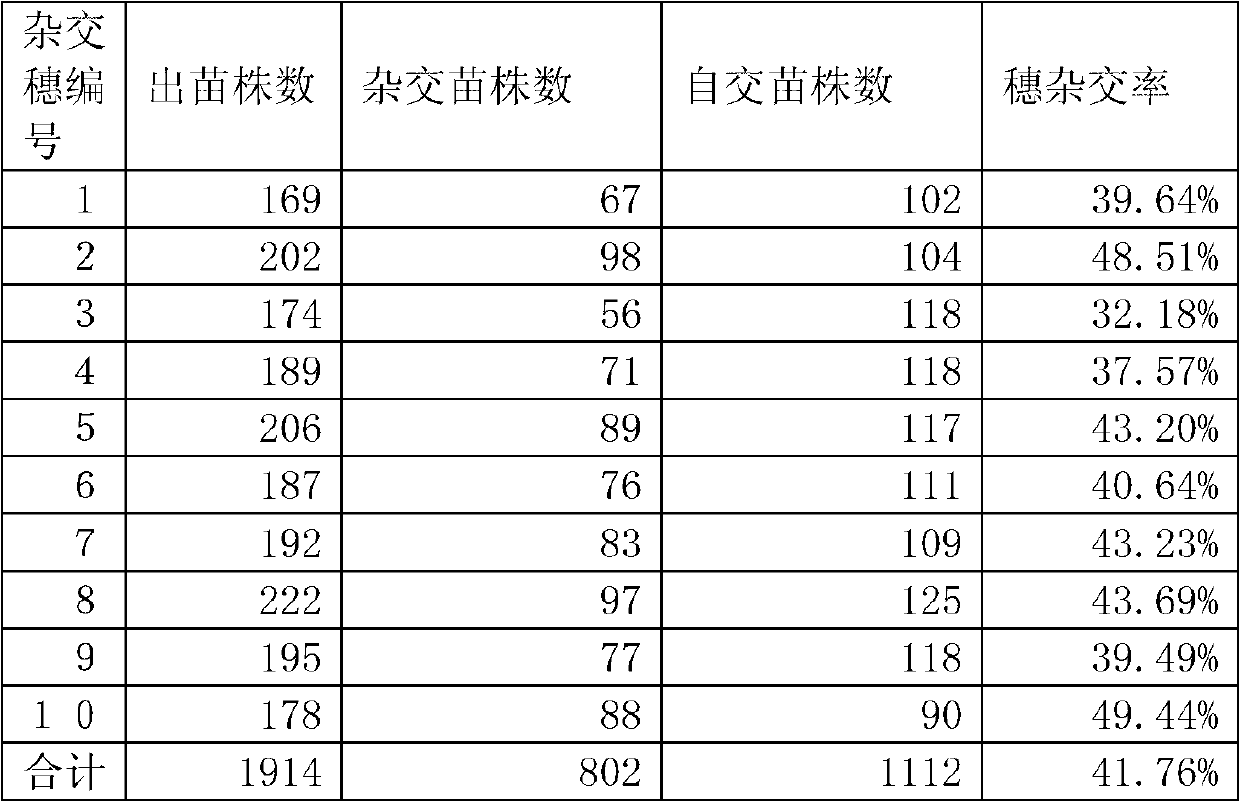Artificial hybridization method for millet
A technology of artificial hybridization and millet, applied in the field of millet hybridization, can solve the problems of low efficiency of emasculation, incomplete emasculation, and high technical requirements, so as to improve the hybridization rate and work efficiency, prolong the working time of emasculation, and save operation time. Effect
Inactive Publication Date: 2012-10-24
ZHANGJIAKOU ACAD OF AGRI SCI
View PDF4 Cites 4 Cited by
- Summary
- Abstract
- Description
- Claims
- Application Information
AI Technical Summary
Problems solved by technology
The method of manual surgical defloration is to remove the stamens one by one before pollination. This method has a high true hybridization rate, but the detasseling work efficiency is too low, the technical requirements are high, and it is difficult; the warm water method is to use male and female The stamens respond differently to temperature. Soaking the female ear in warm water kills the stamens and does not harm the pistils. Generally, soak in warm water at 45-47°C for 7-15 minutes. This method is fast but not complete. The true hybridization rate is low, and it is easy to control the length of killing males due to different water temperatures, so that the pollen cannot be killed or the stigma can be injured.
These detasseling methods of millet have their own advantages and disadvantages. The operation is either slow, or the detasseling is not complete, which is always unsatisfactory. A better method is needed to replace it to promote the development of millet hybrid breeding
Method used
the structure of the environmentally friendly knitted fabric provided by the present invention; figure 2 Flow chart of the yarn wrapping machine for environmentally friendly knitted fabrics and storage devices; image 3 Is the parameter map of the yarn covering machine
View moreImage
Smart Image Click on the blue labels to locate them in the text.
Smart ImageViewing Examples
Examples
Experimental program
Comparison scheme
Effect test
Embodiment 1
[0024] Embodiment 1, the artificial hybridization of No. 21 of Jingu and No. 5 of Ji Zhanggu
the structure of the environmentally friendly knitted fabric provided by the present invention; figure 2 Flow chart of the yarn wrapping machine for environmentally friendly knitted fabrics and storage devices; image 3 Is the parameter map of the yarn covering machine
Login to View More PUM
 Login to View More
Login to View More Abstract
The invention discloses an artificial hybridization method for millet. The method comprises the following steps: 1) for ears of maternal plants of millet with the total number of flowers accounting for 10 to 15% of the total number of spikelets, removing a part of seed strings of the ears until each of the ears has 15 to 25 seed strings and removing all the blossomed flowerets and unfully-grown flowers in the retained seed strings; 2) wetting the ears of the maternal plants processed in step 1), wrapping the ears of the maternal plants to allow the ears to be in an environment with a temperature of 23 to 30 DEG C and relative air humidity of more than 95% and carrying out emasculation and pollination after 18 to 21 h; and 3) culturing pollinated plants under the condition that the ears ofthe maternal plants are isolated from external pollen and collecting seeds. According to the invention, a method of moisture retention and emasculation through wrapping is employed; therefore, cracking of anther of the maternal plants is effectively prevented, working time for emasculation can be prolonged, and mechanical damage to stigma during manual emasculation is avoided.
Description
technical field [0001] The invention relates to a method for millet hybridization, in particular to a method for artificial hybridization of millet. Background technique [0002] Millet (Setaria italic) has the characteristics of drought resistance and barrenness tolerance. It is a traditional dominant grain and feed crop. It is mainly planted in the arid, semi-arid and semi-humid and drought-prone regions of North China, Northwest and Northeast China, and sporadically planted in the South. Among them, Hebei Province has the largest planting area, followed by Shanxi Province and Inner Mongolia Autonomous Region. After the millet is shelled, it becomes millet, which is rich in nutrition and balanced, and its edible crude fiber is 5 times that of rice. People in the north mainly eat porridge. The crude protein content of forage grass is relatively high, which is equivalent to that of alfalfa. The crude protein content of millet straw for grain production is about 8%, and the ...
Claims
the structure of the environmentally friendly knitted fabric provided by the present invention; figure 2 Flow chart of the yarn wrapping machine for environmentally friendly knitted fabrics and storage devices; image 3 Is the parameter map of the yarn covering machine
Login to View More Application Information
Patent Timeline
 Login to View More
Login to View More Patent Type & Authority Applications(China)
IPC IPC(8): A01H1/02
Inventor 宋国亮赵治海王晓明王峰杜贵张文英邱风仓王德权范广宇苏旭史高雷张晓雷冯小磊
Owner ZHANGJIAKOU ACAD OF AGRI SCI
Features
- R&D
- Intellectual Property
- Life Sciences
- Materials
- Tech Scout
Why Patsnap Eureka
- Unparalleled Data Quality
- Higher Quality Content
- 60% Fewer Hallucinations
Social media
Patsnap Eureka Blog
Learn More Browse by: Latest US Patents, China's latest patents, Technical Efficacy Thesaurus, Application Domain, Technology Topic, Popular Technical Reports.
© 2025 PatSnap. All rights reserved.Legal|Privacy policy|Modern Slavery Act Transparency Statement|Sitemap|About US| Contact US: help@patsnap.com

